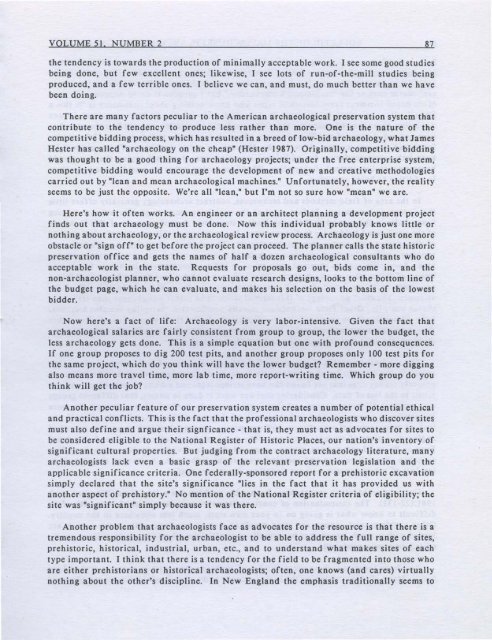No. 2 – October 1990
No. 2 – October 1990
No. 2 – October 1990
Create successful ePaper yourself
Turn your PDF publications into a flip-book with our unique Google optimized e-Paper software.
VOLUME 51. NUMBER 2 87<br />
the tendency is towards the production of minimally acceptable work. I see some good studies<br />
being done, but few excellent ones; likewise, I see lots of run-of-the-mill studies being<br />
produced, and a few terrible ones. I believe we can, and must, do much better than we have<br />
been doing.<br />
There are many factors peculiar to the American archaeological preservation system that<br />
contribute to the tendency to produce less rather than more. One is the nature of the<br />
competitive bidding process, which has resulted in a breed of low-bid archaeology, what James<br />
Hester has called "archaeology on the cheap" (Hester 1987). Originally, competitive bidding<br />
was thought to be a good thing for archaeology projects; under the free enterprise system,<br />
competitive bidding would encourage the development of new and creative methodologies<br />
carried out by "lean and mean archaeological machines." Unfortunately, however, the reality<br />
seems to be just the opposite. We're all "lean," but I'm not so sure how "mean" we are.<br />
Here's how it often works. An engineer or an architect planning a development project<br />
finds out that archaeology must be done. <strong>No</strong>w this individual probably knows little or<br />
nothing about archaeology, or the archaeological review process. Archaeology is just one more<br />
obstacle or "sign off" to get before the project can proceed. The planner calls the state historic<br />
preservation office and gets the names of half a dozen archaeological consultants who do<br />
acceptable work in the state. Requests for proposals go out, bids come in, and the<br />
non-archaeologist planner, who cannot evaluate research designs, looks to the bottom line of<br />
the budget page, which he can evaluate, and makes his selection on the basis of the lowest<br />
bidder.<br />
<strong>No</strong>w here's a fact of life: Archaeology is very labor-intensive. Given the fact that<br />
archaeological salaries are fairly consistent from group to group, the lower the budget, the<br />
less archaeology gets done. This is a simple equation but one with profound consequences.<br />
If one group proposes to dig 200 test pits, and another group proposes only 100 test pits for<br />
the same project, which do you think will have the lower budget? Remember - more digging<br />
also means more travel time, more lab time, more report-writing time. Which group do you<br />
think will get the job?<br />
Another peculiar feature of our preservation system creates a number of potential ethical<br />
and practical conflicts. This is the fact that the professional archaeologists who discover sites<br />
must also define and argue their signficance - that is, they must act as advocates for sites to<br />
be considered eligible to the National Register of Historic Places, our nation's inventory of<br />
significant cultural properties. But judging from the contract archaeology literature, many<br />
archaeologists lack even a basic grasp of the relevant preservation legislation and the<br />
applicable significance criteria. One federally-sponsored report for a prehistoric excavation<br />
simply declared that the site's significance "lies in the fact that it has provided us with<br />
another aspect of prehistory." <strong>No</strong> mention of the National Register criteria of eligibility; the<br />
site was "significant" simply because it was there.<br />
Another problem that archaeologists face as advocates for the resource is that there is a<br />
tremendous responsibility for the archaeologist to be able to address the full range of sites,<br />
prehistoric, historical, industrial, urban, etc., and to understand what makes sites of each<br />
type important. I think that there is a tendency for the field to be fragmented into those who<br />
are either prehistorians or historical archaeologists; often, one knows (and cares) virtually<br />
nothing about the other's discipline. In New England the emphasis traditionally seems to
















